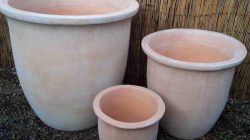Uses and Applications
Small plastic plant pots, seemingly humble objects, play a vital role in the world of horticulture, from sprawling commercial nurseries to cozy home gardens. Their ubiquitous presence stems from their versatility and practicality, making them indispensable tools for plant propagation and cultivation across diverse scales of operation. Their impact extends beyond simple containment; they significantly influence plant health, growth, and ultimately, the success of horticultural endeavors.These unassuming containers are far more than just vessels; they are the cradles of life for countless plants.
Their design, while seemingly simple, allows for efficient water drainage and aeration, crucial factors in preventing root rot and promoting healthy root development. This is especially important during the vulnerable seedling stage, when young plants are most susceptible to environmental stressors. The ease with which these pots can be moved and arranged allows for optimal sunlight exposure and efficient space management, whether in a vast commercial greenhouse or a small balcony garden.
Commercial Nursery Applications, Small plastic plant pots
Commercial nurseries utilize small plastic plant pots on a massive scale. Imagine vast rows upon rows of these pots, each cradling a carefully nurtured seedling destined for retail sale. These nurseries often employ automated systems for potting, watering, and transplanting, streamlining the process and maximizing efficiency. The standardized size and shape of the pots facilitate easy handling and mechanized processes, contributing to cost-effectiveness and large-scale production.
The choice of pot material, often a durable and recyclable plastic, aligns with the environmental concerns of many modern nurseries. Furthermore, the pots’ ability to retain moisture while allowing for proper drainage minimizes water waste, a significant concern in large-scale operations.
Home Gardening Applications
In contrast to the industrial scale of commercial nurseries, home gardeners utilize small plastic plant pots in a more intimate and personalized manner. They provide a controlled environment for starting seeds indoors, protecting delicate seedlings from harsh weather conditions and pests. The portability of these pots allows for easy relocation as needed, optimizing sunlight exposure and plant growth.
Home gardeners also appreciate the affordability and accessibility of these pots, making them a budget-friendly option for hobbyists of all levels. Moreover, the ability to easily transplant seedlings from small pots to larger containers as they grow simplifies the gardening process for novice and experienced gardeners alike.
Improving Usability and Functionality
User feedback consistently points towards areas for improvement in small plastic plant pots. Many consumers express concerns regarding durability, particularly with cheaper models prone to cracking or breaking under stress. Aesthetics are another recurring theme; while functionality is paramount, a more visually appealing pot can enhance the overall gardening experience. Ease of use, especially for elderly or physically challenged individuals, also presents a significant area for improvement.
Potential Improvements Based on User Feedback
Improving the usability and functionality of small plastic plant pots requires a multi-faceted approach. A list of potential improvements based on common user feedback includes:
- Increased durability through the use of stronger, more impact-resistant plastics.
- Improved drainage systems to prevent waterlogging and root rot, perhaps incorporating self-watering features.
- Ergonomic designs that are easier to handle and less prone to slipping.
- Aesthetic enhancements, such as incorporating attractive colors, textures, or patterns.
- Improved labeling and markings for easier identification of plant types and planting dates.
- The development of biodegradable or compostable alternatives to reduce environmental impact.
FAQ: Small Plastic Plant Pots
Can I reuse small plastic plant pots?
Absolutely! Thoroughly clean and disinfect them before reusing. Consider using them for storage or other craft projects.
Are all small plastic plant pots made from the same type of plastic?
No, various types of plastic resins are used, each with different properties impacting durability, cost, and recyclability.
How do I dispose of small plastic plant pots responsibly?
Check with your local waste management authority for recycling options. Many communities have programs for specific plastics, or you may find local recycling centers that accept them.
What are the benefits of using biodegradable plant pots?
Biodegradable pots reduce plastic waste and can often be planted directly into the ground, eliminating the need for transplanting.
Yo, so like, small plastic plant pots are, like, totally everywhere, right? But if you need something bigger for your monstera, check out this ikea plant pot 12 inch , it’s seriously dope. Then, once your plant outgrows that, you can always grab more of those little plastic pots for propagating cuttings—it’s a whole vibe.








